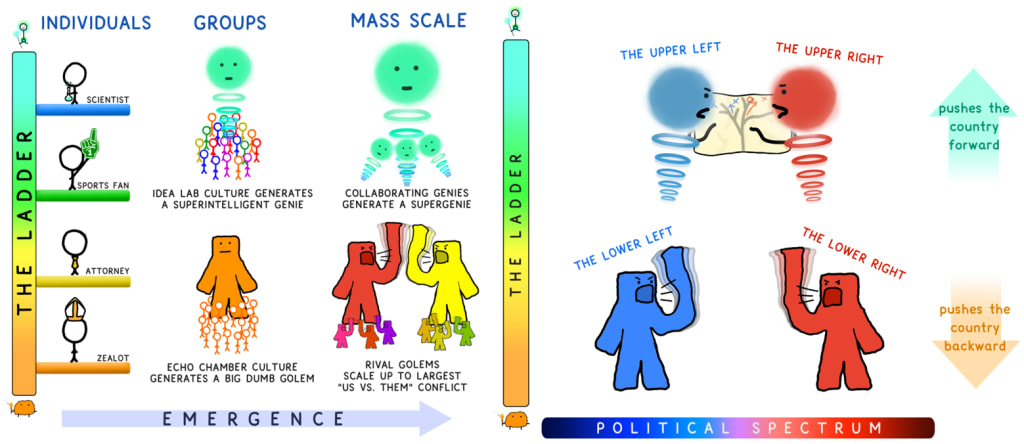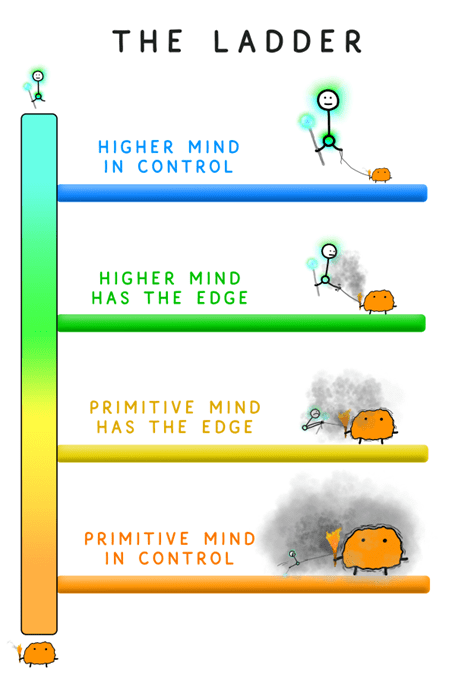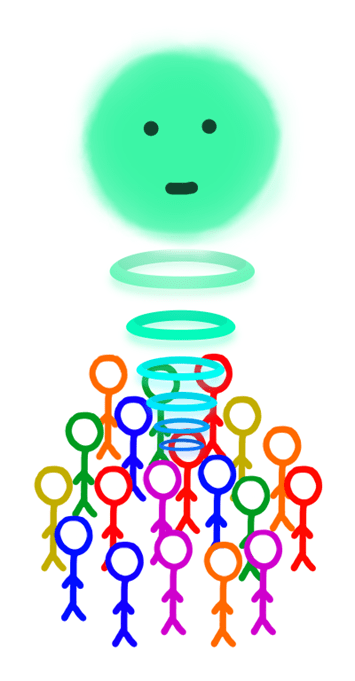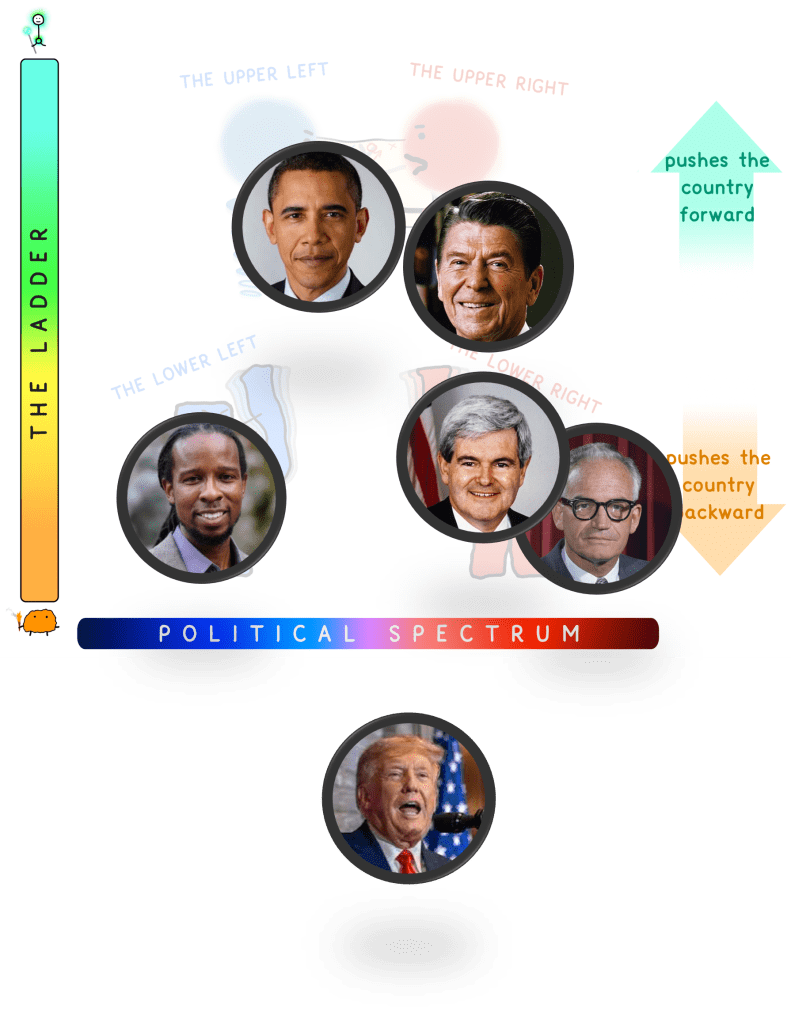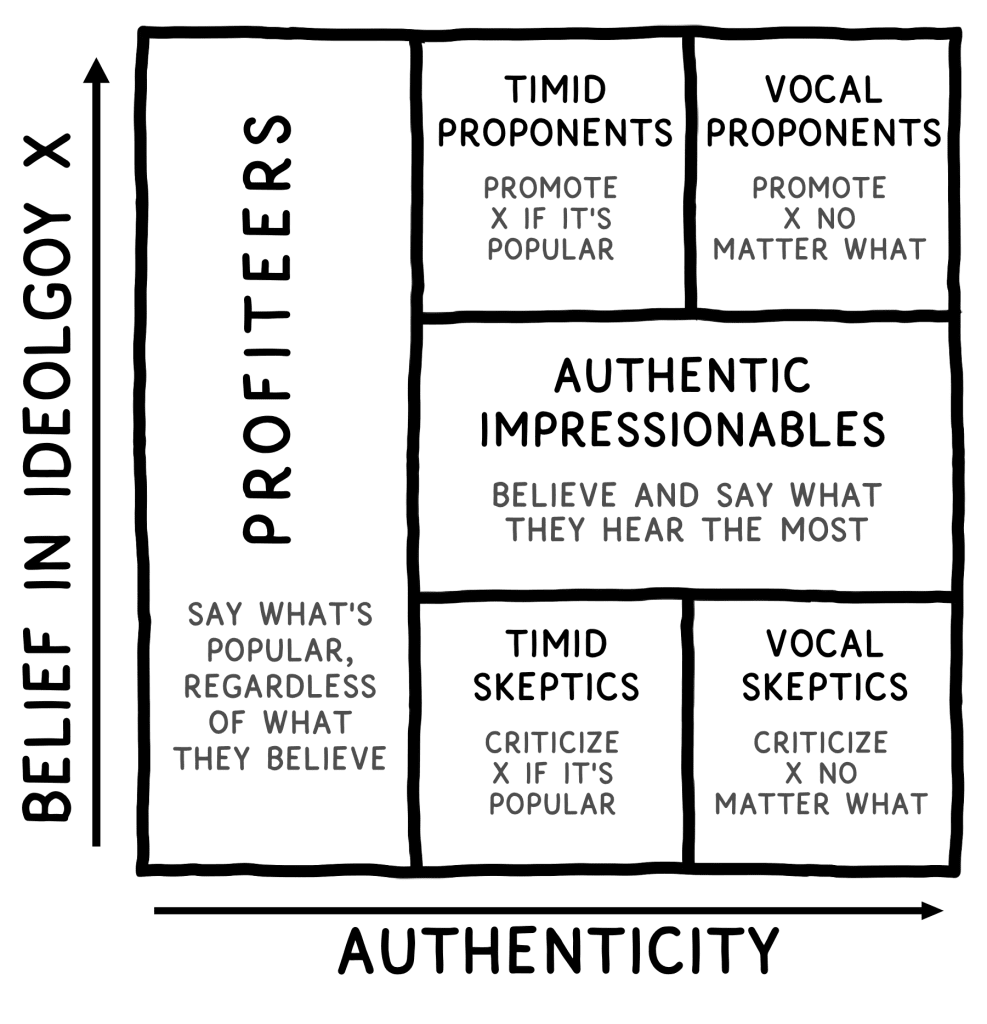What's Not Our Problem
post by Jacob Falkovich (Jacobian) · 2023-03-09T20:07:47.527Z · LW · GW · 6 commentsContents
Wherefore our higher and lower rung thinking? Are we all equal in our capacity for higher and lower rung thinking? Is the political square a square? Why did academia, media, and NGOs get taken over by wokism? Why does Robin DiAngelo exist? None 7 comments
Cross-posted, as always, from Putanumonit.
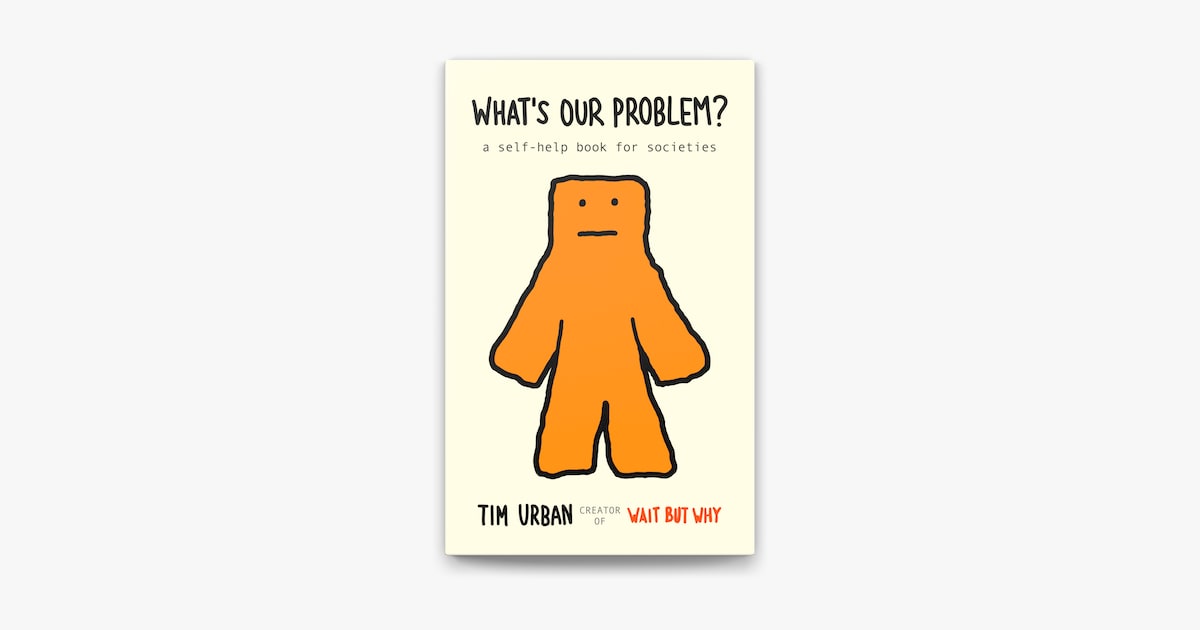
Putanumonit started in 2015, and like every rationalist blogger at the time my main inspirations were Scott Alexander and Tim Urban. In the year prior, Scott wrote a remarkable series of posts transforming how I understand politics and political psychology: motte and bailey, politics as fashion, tolerating the outgroup, toxoplasma, and how social justice ideology is being used to grab power and exercise cruelty. Meanwhile, Tim successfully ignored politics to write great posts on technology, relationships, and procrastination. I went out of my way to meet both in person, got entirely conflicting advice from the two very different writers, and dove into this blog.
In 2016, as millions of human brains were getting hijacked by Trump and wokeness and Trump vs. wokeness, my most popular posts were about buying soap, dating profiles, and Pokemon Go . I was relieved to see that Scott was mostly ignoring the madness and writing about economics and psychiatry and aliens, and surely Tim would… uh oh, where has Tim disappeared to?
In 2016 Tim fell down a six-year rabbit hole of thinking about US politics, and the sociology of politics, and how Americans think about politics. The result is What’s Our Problem, a joyfully illustrated book on how the existential problems with our national politics stem from the internal conflict between “higher” and “lower” cognition in each individual’s mind.
The book starts by laying out this dichotomy. Higher rung thinking is truth seeking, open to challenge, curious, and scientific. Groups of high rung thinkers collaborate in “idea labs” that magnify their constituents’ ability to discover and share truth and good ideas. Lower rung thinking is tribal, close-minded, confirmation biased, and zealous. Low rung thinkers coalesce into echo chambers that enforce conformity and disable their members’ individual thinking skills. This scales up to the country as a whole, adding a vertical dimension to the left-right political spectrum:
What’s Our Problem lays out some interesting dynamics that can move a nation’s political climate up and down the ladder, such as whether tribalism is distributed across many scales (international, inter-party, and among sub-factions) or concentrated in the Republican vs. Democrat conflict. It briefly reviews the ladder-informed history of the Republican Party in the last century, from supporting civil rights to being pulled down and to the right by Barry Goldwater, up again by Reagan, and crashing back to the bottom with Trump (I’m sure it’s a coincidence that the “big dumb golem” on the cover is an orange man). This takes us through the first 30% of the book, leaving the reader mildly inspired to cheer for hugh-rungism and the founding fathers and mildly miffed at the cowardly mainstream Republicans who repeatedly let the party of Lincoln down.
The rest of the book is a detailed litany of the crimes of wokism against whites, blacks, professors, students, journalists, readers, truth, beauty, kindness, and humanity as a whole. Activists taking over organizations like Evergreen College and ACLU to purge anyone who doesn’t comply with compelled speech codes. Public health officials cheering on riots during COVID-19 and withholding vaccines from white seniors in the name of equity. Schoolchildren being forced to fill worksheets on their complicity in white supremacy. The media lying about everything all the time. Robin DiAngelo existing.
Then there’s a brief chapter at the end about how if we all tried being a little bit braver and a lot more rationalist we could get out of this spiral before the plane crashes in a fiery heap.
There are two plausible purposes What’s Our Problem could serve. The first is getting young college grads whose default class allegiance is to progressivism to join the gray tribe instead by appealing to their self-conception as hip and intelligent. This is good and based, and Tim is probably pretty skilled at it. He mentions throughout the book his numerous conversations with normie educated leftists who don’t see why anyone would be anti “antiracism”; presumably he wrote the book because he was getting some traction and discovering which arguments work to deconvert the faithful.
The other plausible purpose is to give a true account of how politics works. In this aspect the book is either laughably naïve — Scott called it “strange and innocent” — or a work of intricate Straussian genius.
What’s Our Problem is a book about ideology and politics that seems entirely unaware of the existence of Machiavelli, Girard, Lasch, any political thinkers from outside the US, and any conservatives who aren’t on TV. That leaves Stephen Pinker, Jonathan Haidt, Ezra Klein, and pre-2020 Scott Alexander as the main visible influences. These aren’t terrible influences, but they are very similar and together cover a tiny corner of the universe of political thought.
More tellingly, the various theories and observations in the book raise very obvious questions that Tim is exceedingly careful to avoid acknowledging. He tip-toes around them with such care that they emerge in sharp detail in the negative space left by text itself. I found these holes to be more interesting and thought provoking than the donut around them. So the rest of this post is a review not of the book but of the anti-book, the puzzle pieces visible in their conspicuous absence from the book. This anti-book hints at a very different story, and a very different solution to our problem.
Wherefore our higher and lower rung thinking?
Where do the two kinds of cognition outlined above come from? Tim explains that the lower rung thinking evolved to help us survive and reproduce in the small tight-knit tribes of our ancestral environment, making sure we stay aligned and protected by the community one’s life depended on. So does that mean that higher rung thinking evolved to get us ostracized and killed? Was it invented by Locke or Voltaire and transmitted through middle school civics class? And why does the open and anonymous internet, the environment most unlike a small blood-related tribe scraping for survival, make most people burrow into echo chambers instead of ascending into idea labs?
The first multi-agent model [? · GW] of psychology is likely Plato’s tripartite soul. It comprises the rational-head-man, the spirited-heart-lion, and the voracious-somach-monster. These have clear teloi and relationships: the man pursues long term abstract goals (primarily, the happiness that comes from wisdom and virtue) and can be educated by philosophy, the lion purses medium-term social goals and can trained by honor and shame, the monster keeps the body alive by pursing immediate needs and must be tamed by the man and lion.
Tim’s model of higher mind and primitive mind playing tug-of-war on a leash lacks even the detail and explanatory depth of Plato, let alone the 24 centuries of progress in psychology since ancient Athens. And it also lacks another key pillar of Plato’s thought, one that may seem quite relevant to politics.
Are we all equal in our capacity for higher and lower rung thinking?
Like Tim’s genies and golems arising from groups of high and low rung thinkers, Plato also articulated the principle of emergence and the parallels between a single human mind and a society. As each person should be governed by their head, Plato argued that society should be ruled by a caste of philosophers, guiding the city with a long-term vision of virtue and peace. They would direct a class of soldiers/guards, equivalent to the lion part of the psyche, and the guards would keep those segments of the population driven by their gut monsters in line. The ruling philosophers will of course be chosen from those men and women who are able to fully cultivate the rational part of their psyche, a group that Plato imagined would be a small minority even among the children of the previous generation’s aristocrats.
The word “elite” shows up few times in What’s Our Problem, and never (if memory serves) as a noun or with a wholly positive connotation. Tim’s high rung thinkers are multicolored but otherwise entirely identical. Just like all the people you see around you, right?
Is the political square a square?
Tim insists that the high-low axis is truly orthogonal to the left-right political axis, and that any combination of values on these two dimensions is possible. But Tim’s descriptions of various political figures are conspicuously missing anyone in the top left and top right corners:
People hold political positions because they believe certain facts or uphold certain values. A position being on the extreme right or left is opposed by the majority of Americans, and anyone holding that position either disregards that majority’s factual arguments or is willing to ride roughshod over their values. That’s not what high rung wisdom and kindness are supposed to do.
Scott calls the book a defense of “enlightened centrism” and that’s almost certainly where Tim is on most issues. But “centrism” doesn’t quite cover everything. If I was crowned king of America, my policy priorities would be something like the following:
- Monopolize GPU production by any means necessary, including sabotaging foreign producers and bribing Taiwanese engineers to immigrate. Restrict AI proliferation until good alignment is demonstrated.
- Green card for anyone under the age of 35 who scores above the 90th percentile on the SAT. Charge an immigrant tax if the initial demand is too high.
- Land/resource value tax and zoning reform.
- Shorten the NBA regular season to 58 games.
- Listed prices include tax now. Like, come on, this one’s a layup.
- Nuclear power plants.
- Seriously, can we buy Greenland?
- Shut down the cheese cave!
Most of these aren’t so much “centrist” as simply outside the current left-right spectrum. The sorts of political positions that become politicized on the spectrum extremes are those that provide clear loyalty signals for one tribe or another while having little impact on voters’ lives (e.g. Israel/Palestine for American voters) or those that give the people in power more power to exercise (e.g. foreign wars, COVID lockdowns and mandates).
High rung thinking will almost always land on “centrist” position because it acknowledges tradeoffs, or on non-politicized positions because it’s not beholden to supporting either of the two parties in a zero-sum game. It’s not a coincidence that the political square is a triangle.
Why did academia, media, and NGOs get taken over by wokism?
In the long chapters on social justice fundamentalism, Tim laments that it’s the institutions that are supposed to be bulwarks of free inquiry and high rung thinking that were taken over by the most illiberal cadres. Harvard (where Tim went to school, as the book repeatedly mentions), prestige newspapers, ACLU — even among corporations it was Google with their supposed mission of freeing the world’s information that had an internal woke mob force James Damore’s firing and not, say, Alcoa or Walmart. What’s Our Problem asks: how could people walk past the inscription VERITAS (the motto of Harvard, where Tim went to school) and lose sight of their commitment to truth?
Tim blames “the high rung immune system” that failed to kick in for every institution in turn that betrayed all of its stated principles to prostrate itself before the first woke mob that materialized. But how exactly is this “immune system” supposed to work? Was anyone specifically hired at UCLA or Washington Post to safeguard high-rungness?
Tim’s model of ideological takeover is laid out in the chart above. A community with many authentic members could have prolonged debate on any issue, with some impressionables getting convinced for each side. But in a place where most people are profiteers, the latter will join whichever side seems to hold the slightest edge in power and popularity, rapidly overwhelming their opponents. They are also the ones likeliest to push for harsh punishment of dissenters, to signal the clarity of conviction they know they lack. The proportion of profiteers seems highly correlated with the number of VERITAS plaques on campus and the high-mindedness of the organization’s mission statement.
It is interesting to note that Donald Trump’s low rung influence mostly spread through individuals and small groups, not major right wing institutions like Koch Industries, megachurches, or the military. But on the left, susceptibility to ideological takeover has been highly correlated with institutional prestige for the better part of a century. Tim talks about not inferring causation with mere correlation, but here he is suspiciously careful to infer only coincidence from a very suggestive correlation.
Why does Robin DiAngelo exist?
There are many versions of “antiracism” that are espoused in the US. Some are high-rung like evidence-based orgs focused on criminal justice reform. Some are wild conspiracy theories about mad scientists who created white people by grafting gorillas. There are peaceful movements aiming for reconciliation, and militant groups agitating for violent race war. But the version that took over the nation, showing up everywhere from children’s books to workplace diversity trainings is not any of those. Instead, it’s the most retarded one.
The heart of White Fragility is the jejune kafkatrap of asking a white person whether they’re racist and interpreting each possible answer as follows:
- “I’m racist” = Subject admits that they are racist.
- “I’m not racist” = Denying their role in systematic oppression is extra racist.
- “I refuse to participate in this dumb shit” = Subject demonstrates white fragility, a form of racism so powerful and pervasive that they are unable to even address the issue. They are super duper racist and must buy at least 10 copies of the book to make up for it.
The other feature of the dominant antiracism is that it’s maximally insulting to blacks. From claiming that blacks are so frail that a microaggression wounds them like physical violence, to listing hard work, rationality, and delayed gratification as symptoms of “whiteness”. Blacks don’t even get their own grade-school level kafkatrap. An African American who says that they haven’t been harmed by racism is deemed to exhibit “false consciousness” and “internalized white supremacy”, the equivalent of sticking fingers in your ears and shouting “na na na I can’t hear you” at them.
What’s Our Problem explains why antiracism is popular: the civil rights movement was an inspiring success and white people still feel bad for all the decades when racism was really popular. The book also explains why DiAngelo’s antiracism is so moronic and insulting, and notes that racial sensitivity trainings never help and often backfire. But as with the correlation between institutional prestige and vulnerability to wokism, Tim never wonders if White Fragility is pervasively used because, not in spite, of its inanity.
What’s Our Solution?
The final chapter of What’s Our Problem offers great advice on losing your low rung political convictions. Ask why you believe what you believe about politics, who installed those ideas in you and when and whether they’re due for an update. Humanize your political opponents, think about their normal human lives outside of this one heinous thing they believe. See if you can steelman their position or pass their ideological Turing test [? · GW]. Find the courage to not repeat slogans you don’t believe (and note, for discussions of courage, the date my post was written vs. the date What’s Our Problem came out).
Yates wrote that “the best lack all conviction”. Tim writes: to lose all conviction is best. Be humble, stay open-minded, climb the rungs. And I completely agree: I’m a political passivist, and seek no influence on political power (except by accident, and not necessarily in the direction I wanted).
But What’s Our Problem is subtitled A Self-Help Book for Societies. While most political activism is harmful to the polity at large, political passivism is not a solution. Passivism is quitting smoking, it’s not finding a cure for cancer. It is good for me, personally, and my friends. But power is ultimately held by those with the will to power. That will does not grow in decoupled idea labs, and would immediately corrupt them if it did.
Here are the topics What’s Our Problem carefully steps around:
- The deep core of human motivation and cognition
- Inequality of intellectual capacity and leadership ability
- What determines the political spectrum
- What makes powerful institutions susceptible to ideological takeover
- What makes ideologies rise in prominence and raise armies to defend them
The negative space between the lines of What’s Our Problem is a book about elites and the ruling class. It’s a book about the people who shape the ideologies, not the vast public who are shaped by them. It’s about the path to power and dominion.
I wonder if any of Tim’s young readers will notice this missing book and go looking for it. It is those people who will solve our current problems, and bring new and exciting problems for future exasperated rationalists to write about.
6 comments
Comments sorted by top scores.
comment by Stephen Fowler (LosPolloFowler) · 2023-03-10T00:22:45.187Z · LW(p) · GW(p)
There is a contradiction between you asking me to
Humanize your political opponents, think about their normal human lives outside of this one heinous thing they believe. See if you can steelman their position or pass their ideological Turing test
When a few paragraphs earlier you discuss DiAngelo's form of antiracism and refer to it as "it’s the most retarded one".
Replies from: Viliam↑ comment by Viliam · 2023-03-10T14:30:14.341Z · LW(p) · GW(p)
I am afraid this is mixing together two things:
a) readers should know the art of charitable reading, sometimes even steelmanning;
b) writers sometimes write stupid texts, though.
I think it would be bad to conclude something like "an enlightened reader treats all texts as equally smart, because any failure of the text is always a failure of the reader to be sufficiently charitable".
*
You should be able to steelman DiAngelo’s book. That doesn't change the fact that it is a very stupid book. So it depends on what kind of debate we have.
If we have a debate on racism... and we are so unluckly that DiAngelo's book is literally the only source we have available... then we should try to steelman as much value out of it as possible.
But if we have a debate on "antiracism"... it is perfectly valid to observe that the most popular book on the topic is extremely stupid. One could even wonder whether that was on accident or reflects some deeper truth. For example, if the true goal is loyalty signaling, one signals loyalty better by recommending a stupid book than by recommending a smart one. (Anyone can like a smart book, but only a true "antiracist" will like a stupid book.)
Replies from: LosPolloFowler↑ comment by Stephen Fowler (LosPolloFowler) · 2023-03-11T00:22:26.073Z · LW(p) · GW(p)
You raise some good points but I have to point out that the OP didnt make any effort to steelman anti-racism either.
Replies from: Yoav Ravid↑ comment by Yoav Ravid · 2023-03-11T04:48:57.545Z · LW(p) · GW(p)
You should be able to do so, doesn't mean you should always actually do so. In this post for example, which is a review of Tim Urban's book and DiAngelo's book is only mentioned in passing, there's no need for that.
Replies from: LosPolloFowler↑ comment by Stephen Fowler (LosPolloFowler) · 2023-03-11T10:03:34.966Z · LW(p) · GW(p)
comment by ExCeph · 2023-03-14T05:03:40.985Z · LW(p) · GW(p)
I agree that high-rung thinkers would benefit from putting forth a more collaborative and organized effort to resolve the golem problem, and not limiting themselves to the individual habit-building that Tim refers to in the Answers section of the Changing Course chapter.
There are ways that Idea Labs can reclaim territory that has been ceded to the Power Games–ways to dissolve golems. To bring down a golem, it is not necessary to seek power over policy or institution. Instead of a top-down approach, I prefer to start by deconstructing a golem's narrative.
The deconstruction method starts with a values conversation: establishing understanding of what people actually want, rather than trying to establish a shared picture of the status quo. After identifying the values at stake for people and demonstrating understanding of and respect for those values, the next step is exploring the effects of people’s current methods. This is where people start to see how they might be harming others, and even themselves. The last step is to present alternative approaches for accomplishing their goals, ones they can recognize as preferable. It’s up to them to decide what to do with what they now understand.
Deconstruction takes skill and practice to use reliably, but for quick reference I abbreviate the process as follows:
- Make them comfortable
- Make them think
- Make them choose
The deconstruction approach is unlikely to persuade the entire population of the golem. However, it can persuade enough people that the golem crumbles away as the people within it see the effectiveness of high-rung thinking at solving their problems.
The genie doesn’t have to defeat the golem by beating it at the Power Games. The genie can defeat the golem on the memetic level, by understanding the non-toxic values motivating the people in the golem, and addressing those values constructively, better than the golem itself can. In other words, the genie can show people it knows what they want and can deliver.
To make it faster and easier to identify people’s values, I’ve boiled down people’s motivations and the obstacles they face into some keywords. Expressing what matters most as simply as possible has the added benefit of preventing people from latching onto particular methods of accomplishing their goals. It allows people to recognize satisfactory solutions even if those solutions differ from what the people originally had in mind.
Helping people get on the same page about the criteria for a solution is an essential first step towards building more effective genies, which is my area of specialty.
For more of the tools that a genie would use to do the work of democracy and thereby outcompete golems, here is one of my more recent articles on the subject: https://ginnungagapfoundation.wordpress.com/2022/11/06/democracy-is-in-danger-but-not-for-the-reasons-you-think/.
Thanks for starting this conversation!
comment by Skyler Cheung (skyler-cheung) · 2023-04-20T17:08:48.545Z · LW(p) · GW(p)
A good example of a fringe/extreme idea that is high rung is interracial marriage. As Tim noted, support for interracial marriage in the 1960s was pretty extreme. As time went on it became more mainstream and it used high rung tactics and thinking to achieve that.
So that's a good example of high rung "extremism". Ideas which are right in the future are probably extreme today, and they'll have convinced society through high rungness.
I guess Tim says that the high rung immune system didn't kick in because the institutions did not not bow to public pressure. In the face of SJF pressure, the institutions gave in and did the SJF thing. High rungness would be to not bow like Tim noted with Shopify.
My interpretation is that Tim believes we're all capable of higher rung thinking given the chance. Interestingly there are many similarities between his current system and the animal-human dichotomy in his older post "Religion for the Nonreligous". In it, Tim explains how within our step on the evolutionary intelligence/consciousness staircase there are several subfloors, 1 being default, stupid awareness and 3 or 4 being monk level awareness. In this system step 1 seems to mean "Primmitive Mind in control" and 2 seems to mean "Higher Mind in control" (3 and 4 moments are so rare they're above the highest rungs). In it Tim explains that the longer you are on 1 the harder it is to get higher.
So I guess what I'm trying to say is that the longer your Primitive Mind has been controlling you, the harder it is to climb. But it is always possible to climb.
I hope I answer some of your questions although this is just my interpretation. While Tim outdid himself on this book, reading many negative reviews Tim didn't include many things that could easily have answered their questions (in fact he did say things that does answer their questions and criticisms on Twitter, but it would've been better if he put it in his book).
You did an excellent analysis.
